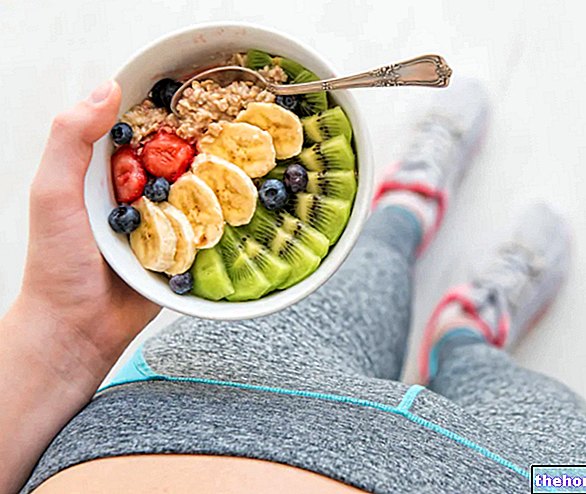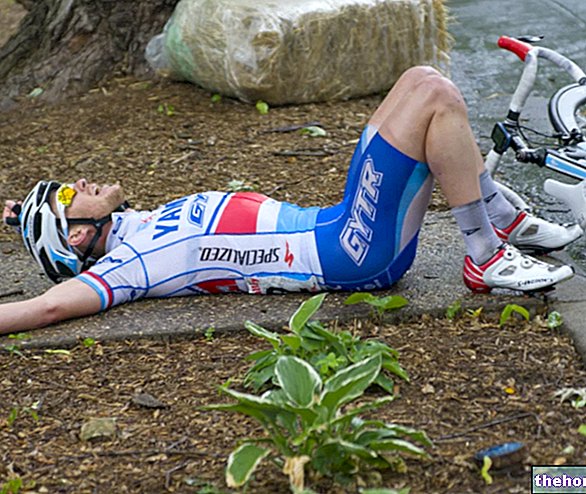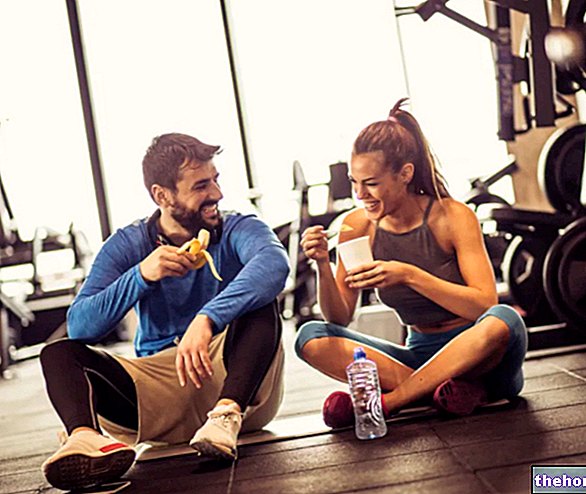. Doubts arise from the awareness that the various foods are different not only in composition, but also in digestive needs, and that all these characteristics must be adapted to the needs of the individual athlete.
Other professionals, on the other hand, base their choice on different aspects that characterize EPOC; these are: the "increase in basic energy expenditure and the" increase in the release of somatotropin (growth hormone or GH). This last mediator, which increases with decreasing blood sugar, during exercise plays a role of glycogenolysis (to increase blood sugar) but, at the same time, prevents (as far as possible ...) excessive muscle catabolism. With the support of GH it would therefore be It is possible to take full advantage of the "increase in basal metabolic rate by postponing the post-workout snack up to more than 60-120" from the end (that is, once the first phase of the EPOC is over).
As it is deducible, the choice of one or the other method depends very much on the objective pursued; the first case mainly concerns bodybuilders in the hypertrophy phase and athletes who practice more than 4-5 weekly workouts. bodybuilders in the cutting phase (definition), those who practice fitness for slimming purposes or athletes who need to reach the weight of a certain category.
In any case, it is better to keep in mind that the post-workout snack becomes essential only when it requires a certain immediacy, that is in the first case. In the second, when the end of the session is placed close to the main meals, there is no need to consume it.
Assuming that the goal is to promote the anabolism of carbohydrates as quickly as possible, the post-workout snack will be early, almost entirely based on medium-high glycemic index carbohydrates, with very few fibers, proteins and lipids (they could be recommended some branched-chain amino acids of supplementary support). So, green light for sweet liquids, fruit juices, rice cakes, rusks, boiled potatoes, ripe bananas, boiled white rice, etc. A second protein and lipid-based post-workout snack cannot be excluded, to be taken after about 1-2 hours apart; this is the case of: yogurt (normal, thickened, lean, whole, etc.), tuna, cooked egg white, lean cold cuts (possibly slightly salty), roast beef and a few oil seeds (almonds, walnuts, hazelnuts, pistachios, pine nuts etc.).
On the other hand, if the anabolic target mainly affects muscle fibers, the snack will certainly be mixed. Carbohydrates with a high glycemic index will act as an insulin stimulator and foods of animal origin as a plastic substrate (amino acids). The temporal tolerance is greater and food can be taken even after 15 "from the end of the workout.The products are the same but in smaller portions; in practice, part of the carbohydrates gives way to proteins. Better to avoid too many fibers and lipids in order not to reduce the glycemic index too much.
Another example concerns the research of adipose catabolism. I would like to underline that in this circumstance training must be carefully thought out (especially in the presence of a slimming diet) to avoid excessively compromising muscle trophism. It is not uncommon that, through the supplementary support with creatine, stimulation protocols of strength, therefore very intense but with few repetitions and lasting about 30-35 "; better to totally avoid aerobic activity. By respecting the criterion mentioned in the previous chapter, the post-workout snack will be taken after at least one "hour from the end (better 90"). The nutritional basis will be mainly of: high biological value proteins or branched amino acids , very few carbohydrates with a low glycemic index, dietary fiber and unsaturated lipids. Protein foods are the same as already mentioned, preferring thickened lean yoghurt and egg white (for the greater biological value); the carbohydrates could be vegetables (especially carrots) or some types of fruit (such as Granny Smith apple or grapefruit or strawberries etc.), while lipid foods are extra virgin olive oil or oil seeds (but it is still advisable to take into account the lipid part contained in protein foods) . With fruit, vegetables and oil seeds also increases the intake of fiber.
The last circumstance that should be mentioned concerns those who try to reduce fat mass in a progressive but very slow way. In this case it is possible to take advantage of a mixed method, in which one tries to block muscle catabolism by exploiting the anabolic window but with the use of foods with a low glycemic index (avoiding as much as possible the stimulus of insulin). This system is often associated with mild and infrequent training protocols, possibly mixed but with a decidedly low intensity aerobic component. This allows the slow but complete recovery of glycogen stores in the time span that passes between workouts.
Tags:
onychomycosis biology diet-and-health
The choice of the post-workout snack should be made respecting some variables; these are: training goal, any pathological conditions, needs of the organism (type of training carried out), frequency and intensity of training, balance of diet for the rest of the day, personal tastes and comfort - practicality of use.
Having said that, it should be noted that the post-workout snack essentially performs 4 functions:

- It supports the body from an energetic point of view and, at times, restores the glycogen stores
- Reduces - slows down - stops muscle catabolism
- Relieves the sense of appetite while waiting for the main meal
- It favors the supply of water and non-energetic nutritional molecules: fibers, vitamins, mineral salts, phenolic antioxidants, phytosterols, lecithins, etc.
Other professionals, on the other hand, base their choice on different aspects that characterize EPOC; these are: the "increase in basic energy expenditure and the" increase in the release of somatotropin (growth hormone or GH). This last mediator, which increases with decreasing blood sugar, during exercise plays a role of glycogenolysis (to increase blood sugar) but, at the same time, prevents (as far as possible ...) excessive muscle catabolism. With the support of GH it would therefore be It is possible to take full advantage of the "increase in basal metabolic rate by postponing the post-workout snack up to more than 60-120" from the end (that is, once the first phase of the EPOC is over).
As it is deducible, the choice of one or the other method depends very much on the objective pursued; the first case mainly concerns bodybuilders in the hypertrophy phase and athletes who practice more than 4-5 weekly workouts. bodybuilders in the cutting phase (definition), those who practice fitness for slimming purposes or athletes who need to reach the weight of a certain category.
In any case, it is better to keep in mind that the post-workout snack becomes essential only when it requires a certain immediacy, that is in the first case. In the second, when the end of the session is placed close to the main meals, there is no need to consume it.
Protein Shake with Almonds, Banana and Cocoa
Problems with playing the video? Reload the video from youtube.
- Go to the Video Page
- Go to the Video Recipes Section
- Watch the video on youtube
Assuming that the goal is to promote the anabolism of carbohydrates as quickly as possible, the post-workout snack will be early, almost entirely based on medium-high glycemic index carbohydrates, with very few fibers, proteins and lipids (they could be recommended some branched-chain amino acids of supplementary support). So, green light for sweet liquids, fruit juices, rice cakes, rusks, boiled potatoes, ripe bananas, boiled white rice, etc. A second protein and lipid-based post-workout snack cannot be excluded, to be taken after about 1-2 hours apart; this is the case of: yogurt (normal, thickened, lean, whole, etc.), tuna, cooked egg white, lean cold cuts (possibly slightly salty), roast beef and a few oil seeds (almonds, walnuts, hazelnuts, pistachios, pine nuts etc.).
On the other hand, if the anabolic target mainly affects muscle fibers, the snack will certainly be mixed. Carbohydrates with a high glycemic index will act as an insulin stimulator and foods of animal origin as a plastic substrate (amino acids). The temporal tolerance is greater and food can be taken even after 15 "from the end of the workout.The products are the same but in smaller portions; in practice, part of the carbohydrates gives way to proteins. Better to avoid too many fibers and lipids in order not to reduce the glycemic index too much.
Another example concerns the research of adipose catabolism. I would like to underline that in this circumstance training must be carefully thought out (especially in the presence of a slimming diet) to avoid excessively compromising muscle trophism. It is not uncommon that, through the supplementary support with creatine, stimulation protocols of strength, therefore very intense but with few repetitions and lasting about 30-35 "; better to totally avoid aerobic activity. By respecting the criterion mentioned in the previous chapter, the post-workout snack will be taken after at least one "hour from the end (better 90"). The nutritional basis will be mainly of: high biological value proteins or branched amino acids , very few carbohydrates with a low glycemic index, dietary fiber and unsaturated lipids. Protein foods are the same as already mentioned, preferring thickened lean yoghurt and egg white (for the greater biological value); the carbohydrates could be vegetables (especially carrots) or some types of fruit (such as Granny Smith apple or grapefruit or strawberries etc.), while lipid foods are extra virgin olive oil or oil seeds (but it is still advisable to take into account the lipid part contained in protein foods) . With fruit, vegetables and oil seeds also increases the intake of fiber.
The last circumstance that should be mentioned concerns those who try to reduce fat mass in a progressive but very slow way. In this case it is possible to take advantage of a mixed method, in which one tries to block muscle catabolism by exploiting the anabolic window but with the use of foods with a low glycemic index (avoiding as much as possible the stimulus of insulin). This system is often associated with mild and infrequent training protocols, possibly mixed but with a decidedly low intensity aerobic component. This allows the slow but complete recovery of glycogen stores in the time span that passes between workouts.





















-nelle-carni-di-maiale.jpg)




